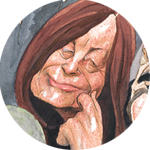 |
|
| Everybody's a critic
Susan Sontag, AB’51 An award-winning novelist (In America garnered the 2000 National Book Award for Fiction) who over the past 40 years also has worked as a playwright, filmmaker, poet, and human-rights activist, Susan Sontag is, somewhat to her dismay, best known for her critical essays. Education. Graduated from Chicago at age 18, Sontag earned master’s degrees in English (1954) and philosophy (1955) from Harvard University. Opening salvo. Her first essay—“Notes on ‘Camp,’” published in a 1964 Partisan Review—displays characteristic self-confidence (or, as the critic’s critics would put it, arrogance). “Many things in the world have not been named,” she begins, “and many things, even if they have been named, have never been described. One of these is the sensibility—unmistakably modern, a variant of sophistication but hardly identical with it—that goes by the name of ‘Camp.’” Explaining her own qualifications to tackle the task, Sontag writes, “I am strongly drawn to Camp, and almost as strongly offended by it. That is why I want to talk about it, and why I can. For no one who wholeheartedly shares in a given sensibility can analyze it; he can only, whatever his intention, exhibit it.” Because the sensibility’s “unnatural” nature makes it “embarrassing to be solemn and treatise-like about camp,” Sontag eschews the essay form in favor of 58 short notes, interspersed with quotations from camp “ideologist” Oscar Wilde: “Camp sees everything in quotation marks” (Note 10); “The whole point of Camp is to dethrone the serious” (Note 41); “Camp taste is above all, a mode of enjoyment, of appreciation—not judgment.” Guiding lights. Sontag also expresses her critical credo in the title essay of Against Interpretation (1966), which argues against viewing an art work’s form and its content separately, with content awarded the greater value. Such an act of interpretation “is the revenge of the intellect upon the world. To interpret is to impoverish, to deplete the world—in order to set up a shadow world of ‘meanings.’ It is to turn the world into this world.” The shadow world of images provides the starting point for On Photography, winner of the 1977 National Book Critics’ Circle Award for Criticism. Its essays explore the paradox that “despite the presumption of veracity that gives all photographs authority, interest, seductiveness, the work that photographers do is no generic exception to the usually shady commerce between art and truth.” For snapshot takers and professional photographers alike, “[t]here is an aggression implicit in every use of the camera.” Sontag reconsiders the uses of photography in Regarding the Pain of Others (a 2003 National Book Critics’ Circle award nominee), refuting her earlier view that repeated exposure to images of war, atrocity, and suffering dull the sympathetic impulse. She wrote On Photography while being treated for metastatic breast cancer (after years in remission, in 1998 she was diagnosed with another form of cancer); Illness as Metaphor (1978), probably her best-known work, grew out of her experiences as a cancer patient. In Illness she shows how diseases like tuberculosis and cancer became symbols for moral decay and how such symbolism has an effect on patients: “Contact with someone afflicted with a disease regarded as a mysterious malevolency inevitably feels like a trespass; worse, like the violation of a taboo. The very names of such diseases are felt to have a magic power.” Taking criticism. Sontag says that she pays little attention to reviews. “I often feel I know what’s wrong better than my reviewer does,” she told The Guardian in 2002. Instead, she continued, she judges her work by taking the long view: “Is it an essay that people will want to read 30 or 50 years from now, which is certainly not the case with most essays?” A piece “works for me if it is saying things which are true, original, and saying them in as eloquent, spirited, lively, and lucid way as I can.” Short list. Against Interpretation And Other Essays (1966); On Photography (1977); Illness as Metaphor (1978); AIDS and Its Metaphors (1989); Where the Stress Falls, a collection of nonfiction (2002); Regarding the Pain of Others (2003). All books published by Farrar, Straus, and Giroux.
|
|
phone: 773/702-2163 | fax: 773/702-8836 | uchicago-magazine@uchicago.edu

